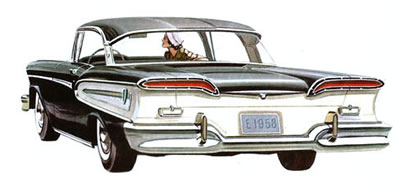 When auto historians look back at the 1958-60 Edsel Division of the Ford Motor Company they come away with two impressions:
When auto historians look back at the 1958-60 Edsel Division of the Ford Motor Company they come away with two impressions:
- It was the wrong car at the wrong time
- It was the wrong market at the wrong time
Ed Breech, then CEO, decided he wanted to go toe-to-toe with General Motors whose five divisions were doing well (2 million cars between 54 and 56). Ford was also feeling traction from that market so the automaker decided to add a new division that would fit between Continental and Mercury. The name Edsel was chosen and planning began in 1955 for the 58. The only problem with this was that no one seemed to know what kind of car they wanted to make, luxury or midline.
The designers also made some very weird choices in their design. For example, the most controversial feature of the 58 and 59 Edsels was, for want of a better term, horse double yoke center grille. It was the most unusual use of an oval grille anyone had seen in Detroit. The rest of the unique front end was dominated by a large chrome bumper and two bright oval grilles set back from the leading edge of the hood. The hood was dominated by a hump that merged into the hood and was even with the top of the front fenders.
Edsel was an ambitious project with four lines, each featuring two-door and four-door sedans, convertibles and two- and four-door wagons that could seat up to 9. It was a project that was full of gadgetry such as the “Teletouch drive” where the gear selector was located on the center of the steering wheel and it had a rather unique spinning counter dial speedometer that wasn’t really all that popular.
The Edsel was a vehicle that really didn’t know what it wanted to be as there was a 124-inch wheelbase version wagon, a 118-inch wheelbase version (Mercury-based) upscale model, and then there was the 116-inch wheelbase version (Ford-based) standard model. The models included the Ranger, Pacer, Corsair and Citation.
The Edsel began life offering two big-block V-8s, a 360-cubic-inch/303 horse model and a monster 460-cubic-inch, 345-horse. These models certainly were powerful but if you wanted them to handle you were on your own. And, as befits this era of drum brakes, you probably had two good stops before terminal fade would set it and stopping became an exercise in having lots of clear road ahead.
The body was pretty much slab-sided, although a reverse curve design was used on the rear quarters as a design feature. It was just an offsetting feature. Overall, the body had a high beltline and a low beltline, making it a thoroughly confusing design. The Edsel wasn’t well made as it featured poorly fitting panels, gaps, noises and interiors that were not well put together.
By 1960, the Edsel, whose reputation for reliability was very suspect, was done. It was actually phased out in November 1959, although 6,000 had been made. By the 1960, you could easily see the Ford Galaxy 500 in its lines with smaller engines and more conventional taillamps.
